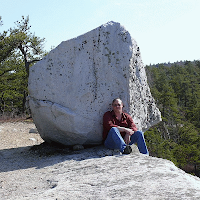Today I parked at the Spring Farm trailhead and followed Table Rock trail. Spotted a neat little plant I know called hepatica (Hepatica nobilis). The name comes from the Greek word for liver because the leaf has three lobes like the human liver. It's a traditional medicinal plant, once thought to be good for the liver due to its shape (the Medieval "doctrine of signatures").
The trail passes through a beautiful meadow, still mostly brown but soon to be filled with grasses and blooming with wildflowers. I love this meadow sitting surrounded by woods. The picture doesn't do it justice. I was walking through the meadow, the warm Sun is shining, the sky is deep blue, the grasshoppers are buzzing, and the birds are singing. I can't even describe how places like this make me feel.
I continued along the trail to a junction. As I was wondering which way to go, I heard a barred owl calling to my right. That decided my direction.
Some wildflowers along the trail. I have a book called Wildflowers of New York
I also saw these plants. They were growing in a moist area. At first I thought they were skunk cabbage but the leaves are different. Anyone know?
And here, for no apparent reason, is a picture of a bumblebee drinking water. I thought it was cool and watched him (her?) for a while.
I also came across some coyote scat. How do I know it's coyote? It was displayed prominantly on top of a rock, looks like dog poop, but is loaded with fur and bones (the white bone in the crushed up piece looks like a little rodent scapula).
This may be why people don't generally go hiking with me. I take pictures of shit.
Anyway, I followed a little-used trail I like (since I never run into people on it) and ended up at Bonticou Crag, one of my favorite places on the Ridge. There's a great "trail" to the top that goes up the front face winding it's way among the talus boulders (Click on the picture to make it larger. See the guy in the red sweatshirt near the top? That's the trail).
Here's a view from near the top looking down (I actually came down that way today).
The most challenging part of the climb is near the top when you have to shimmy up a crevice and then climb along a very exposed ledge for a short distance (not for those afraid of heights). The crevice, like many along the ridge, is actually a strike-slip fault (can't have a post without a little geology).
One of these days I'll write about Bonticou. It's a sacred place.



























